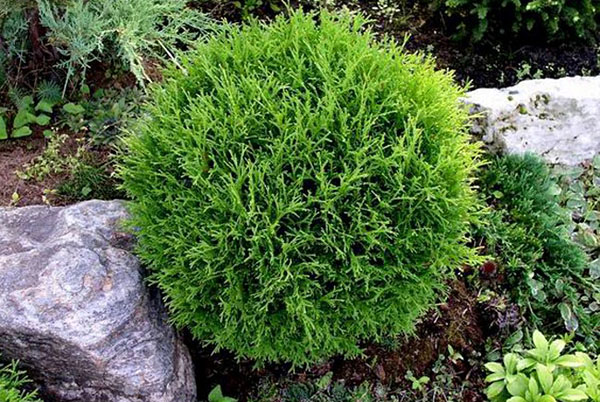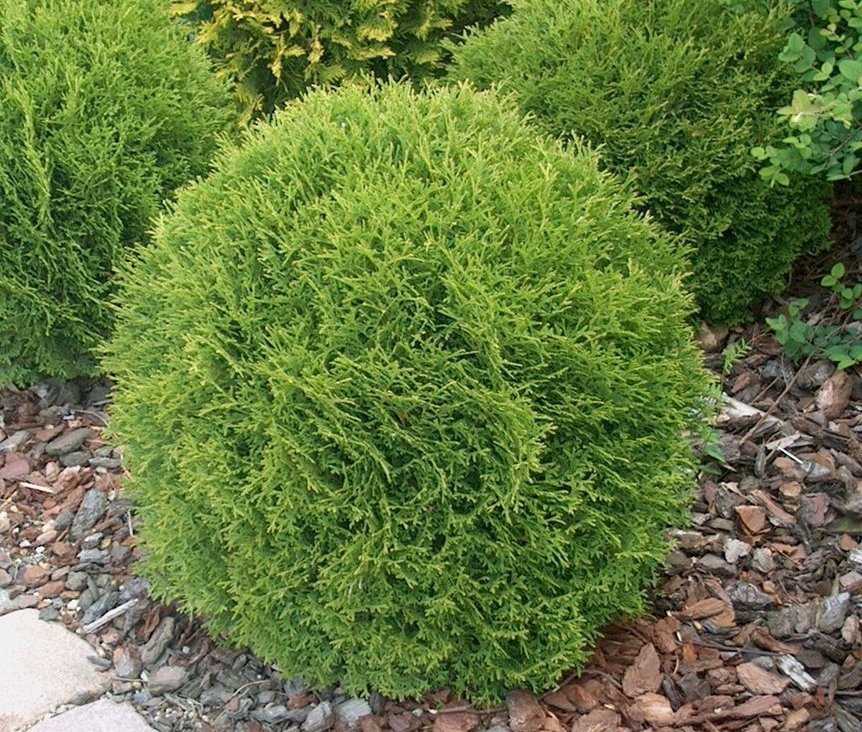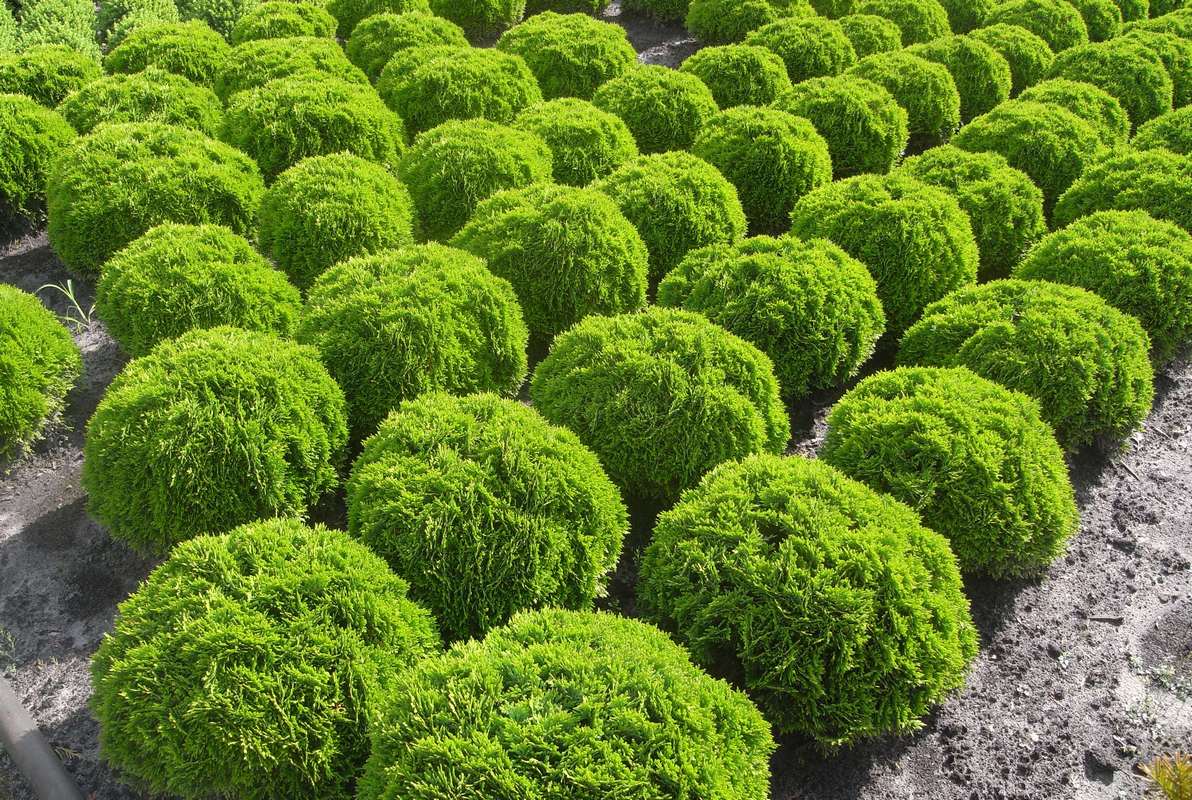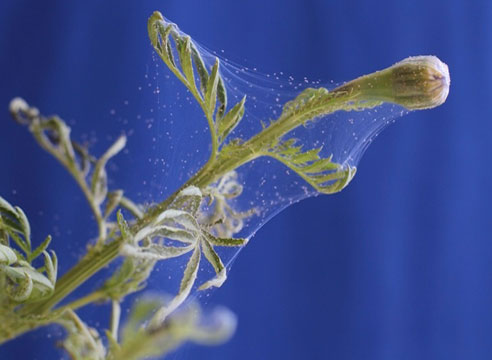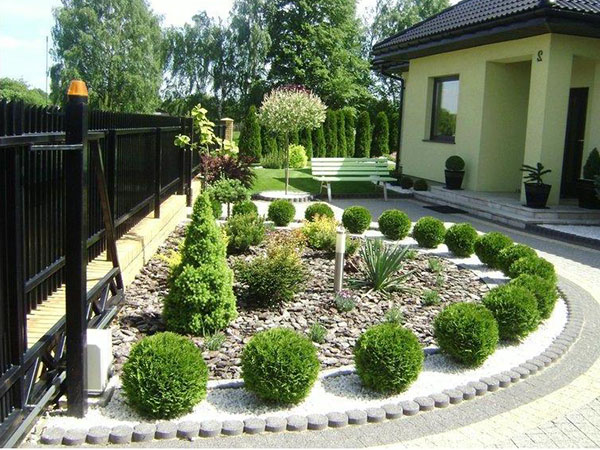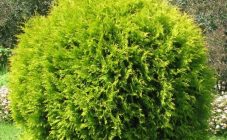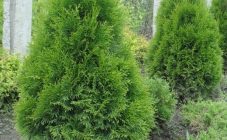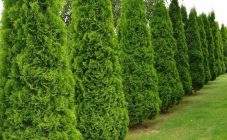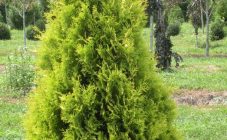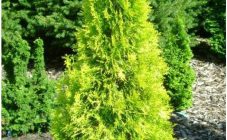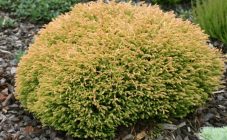Content:
Thuja Danica (Thuja occidentalis Danica) is one of the most common plants in landscape design. It is an evergreen shrub with a dense crown. Thuja western Danica is distinguished by its small growth, not exceeding 80 cm. Borders from thuja Danica look interesting or it is in the middle of perennial plants. The unique appearance makes this look especially attractive to gardeners when creating unique site designs.
History of creation
Originally, the shrub is native to Canada and the United States of America. Being an indigenous breed, thuja was called the “tree of life”. During the colonization of America, it was exported to European countries, where it received its recognition as an ornamental plant. The Danica thuja variety was bred by Danish breeders in 1948, giving the name to the shrub in honor of the country.
Description of the variety
Thuja globular Danica belongs to the dwarf forms of the Cypress family. A distinctive characteristic is a low growth rate - 5 cm per year in all directions. The height of an adult plant does not exceed 60-80 cm, having the same diameter. Thuja Danica reaches its maximum size by the 15th year. With careful care, thuja can grow for 100-150 years. It attracts with its frost resistance shrub for cultivation in the regions of Siberia.
Thuja Danika fully corresponds to the description "spherical". It has a shrub with short shoots of light green color, characterized by a dense arrangement.
Instead of leaves, the needles are soft and shiny, characterized by a scaly structure, densely filling the shoots. In the warm season, it has a rich green color, changing it to brown-green in winter. The needles are directed upward, thanks to this the plant looks more fluffy. Young needles at the ends of the shoots have a needle-like shape. With age, the needles change, becoming like scales that fit tightly to the wood.
The cones of a spherical thuja are small in size, rarely exceeding 0.6 cm. They are brown in color and rounded.
Danica tolerates subzero temperatures well. However, for the winter period it is necessary to cover the thuja bush with spruce branches to prevent the formation of "sunburn" shoots in spring.
The root system of the thuja is located close to the soil surface. This is a limiting factor in soil cultivation.
It is preferable to choose dimly lit areas for thuja growth. Watering should be carefully monitored when planting in direct sunlight. Otherwise, the thuja may dry out. It is better to choose places protected from drafts and strong winds.
Landing technique
Thuja western Danica, planting and leaving of which are not complicated processes, can reproduce in several ways.
You can purchase a thuja seedling or breed them yourself. Planting seeds is an ineffective breeding method for Danica thuja. When sown, a small percentage of seeds sprout and survive. To get a healthy shrub, you need to care for it according to the following rules.
The most successful is the reproduction of thuja Danica by cuttings. To obtain a cutting, it is necessary to remove the needles from the bottom of the shoots.Soak the resulting cutting in warm water for 60 minutes.
After that, plant it in a soil mixture consisting of turf, sand and peat. Install a pot with a small thuja in a warm place and cover the planting with glass containers. Such a structure should be regularly ventilated, otherwise the bush will stop growing and rot.
As the thuja seedling grows, it is necessary to gradually prepare it for external conditions, gradually hardening it. To do this, you need to increase the time without shelter and take the thuja stalk out into the street. This technique will allow you to get a hardy and strong plant.
Tuya Danica does not have special requirements for the composition of the soil. It is preferable to plant young bushes on moist loamy soils. In addition, peat or dry soils are suitable. If the soil is too dense, it is necessary to create at least 15 cm of the drainage layer.
It is better to plant thuja Danica near other trees or bushes. Thus, the shade necessary for the shrub will be created.
The size of the planting pit must be at least 80 cm. The soil mixture prepared in advance must consist of sand, peat and turf in a 1: 1: 2 ratio. The acidity of the soil must be maintained at 4.5-6 pH.
At the bottom of the pit, it is necessary to form a drainage layer of crushed brick, stone chips or expanded clay. The soil must be combined with mineral fertilizers and rotted plant remains.
It is better to plant Danika after warming up the soil in early spring. It is necessary to lower the seedling into the planting hole and sprinkle with prepared soil mixture. Having carefully tamped the ground, you can mulch the near-trunk circle with peat, mown grass or chips. After this, the future shrub should be watered abundantly.
Watering must be carried out at intervals of 1 time in 7 days. This scheme guarantees the active growth and development of the young Danika thuja bush.
Watering and feeding
Under normal conditions, one thuja bush should have 10-12 liters of water. To reduce the frequency of irrigation, you can plant thuja Danica in an area with shallow groundwater. However, one should beware of maintaining constant soil moisture.
To create good aeration of the soil and distribution of moisture, regular loosening is required to a level of 5-7 cm deep due to the close location of the roots to the soil surface. On hot and dry days, it is helpful to spray the entire plant with warm water.
A decrease in the growth rate of thuja can cause a lack or excess of applied fertilizers. During the formation of the planting pit, the fertilizers applied are a sufficient reserve for the first two years of the plant's life. After a couple of years, the soil should be fertilized with a complex preparation. Among the purchased mixtures of thuja, almost all dressings intended for other ornamental plants, for example, Kemira Universal, are suitable.
The decorative spherical shape of the crown is formed independently. To maintain shape, you should refrain from planting thuja Danica closer than 50 cm from other shrubs or trees. In addition, the plant should be regularly inspected for dried or damaged branches. Such shoots should be cut off. Sanitary pruning should be done after snow melts.At this time, you should cut off dry branches broken by snow and wind and needles burned out in the sun.
Diseases and pests
By themselves, thuja shrubs are quite resistant to various diseases and pests. However, they can be susceptible to parasites and infections.
The most dangerous pests for Danica thuja are spider mites, leafworms, speckled moths, thuja beetles and scale insects. When infected with ticks and aphids, the process of yellowing of the needles begins. Infection with needle-gnawing pests is distinguished by the acquisition of a brown color and the death of the tops of the shoots. Soil pests are especially dangerous. Damage to the root system can lead to the death of the shrub.
To prevent the spread of pests, ready-made commercial preparations should be purchased, since the complexity of processing thuja lies in the small size of the needles. For preventive purposes, it is necessary to conduct a thorough examination of the thuja twice a year.
In addition to pests, there are diseases characteristic of thuja:
- Stem rot. Shrub discoloration is the first symptom. The most common cause is the spread of the fungus through the root system. Experts recommend destroying the affected thuja, as there is a risk of contamination of other plants. For preventive purposes, fungicidal agents should be added to the water for irrigation.
- The appearance of a gray shade of needles is a marker of the development of the putrefactive process of the roots. The lower part of Danica's trunk softens and is pressed through. A fungal infection is also the cause. As in the previous case, the only way out is to destroy all the shrubs.
- The appearance of brown mold is noted immediately after the snow melts. A typical manifestation is the formation of spider webs on the shoots. Its formation begins at a temperature of 0 ° C. As a treatment, it is necessary to remove all the cobwebs and inanimate parts of the thuja shoots. It is necessary to treat brown mold with special means, treating the entire plant.
If it is necessary to carry out pest control measures, Actellik and Fufanon preparations have proven themselves well. Their use will help speed up the healing process of a damaged thuja bush.
Use in landscape design
Spherical Danica is often used to decorate decorative borders. In addition, the variety is highly valued by lovers of the alpine slide. Thuja can be planted in group compositions among flowering perennials or as a main plant between stones or soil-bearing species. Used as a frame for creeping perennials in contrast to tall plants or bright flowers fits well into garden design.
The advantage of the western thuja Danica variety is in the small size of an adult plant, so you can find a place to grow it on almost any site. In addition, thuja looks organically when grown in pots, decorating a spacious hall or patio.
In conclusion, we can say that decorating a garden with a variety of thuja Danica will not bring much trouble with care and will be a good design solution when forming the interior of the site.
